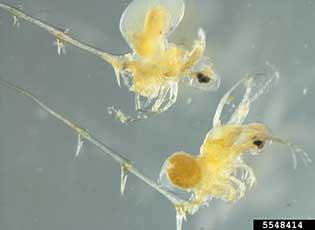Bythotrephes longimanus (Leydig, 1860) (ITIS)
Spiny water flea
Bythotrephes cederstroemi (Yan et al. 2011)
Eurasia (Yan et al. 2011)
First discovered in Lake Huron in 1984; established in all of the Great Lakes by 1987 (Cullis 1988)
Most likely introduced through ballast water (Yan et al. 2011)
Has caused a decline in the population of zooplankton as a result of predation (Vanderploeg et al. 2002); may also compete with some native species, such as perch and small crustaceans (Branstrator and Lehman 1996)

Spiny waterflea, adults
Photo by Gary Montz
Find more images
Distribution / Maps / Survey Status
All Resources
Selected Resources
The section below contains highly relevant resources for this species, organized by source.
Council or Task Force
Partnership
Federal Government
State and Local Government
Academic
Branstrator, D.K. 1995. Ecological interactions between Bythotrephes cederstroemi and Leptodora kindtii and the implications for species replacement in Lake Michigan. Journal of Great Lakes Research 21:670-679.
Cullis, K.I., and G.E. Johnson. 1988. First evidence of the cladoceran Bythotrephes cederstroemi Schoedler in Lake Superior. Journal of Great Lakes Research 14:524-525.
Integrated Taxonomic Information System. Bythotrephes longimanus. [Accessed Sep 25, 2023].
Vanderploeg, H.A., T.F. Nalepa, D.J. Jude, E.L. Mills, K.T. Holeck, J.R. Liebig, I.A. Grigorovich, and H. Ojaveer. 2002. Dispersal and emerging ecological impacts of Ponto-Caspian species in the Laurentian Great Lakes. Canadian Journal of Fisheries and Aquatic Sciences 59:1209-1228.
Yan, N.D., B. Leung, M.A. Lewis, and S.D. Peacor. 2011. The spread, establishment and impacts of the spiny water flea, Bythotrephes longimanus, in temperate North America: a synopsis of the special issue. Biological Invasions 13:2423.
